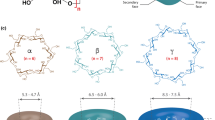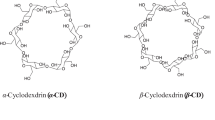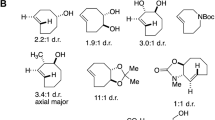Abstract
Click chemistry was used as an efficient method to covalently attach a chromophore to an amino acid. Such easily prepared model systems allow for time-resolved studies of one-electron oxidation reactions by the excitation of the chromophore by a laser flash. The model complex ruthenium—tryptophan (Ru—Trp) has been synthesised and studied for its photophysical and electrochemical properties. Despite a small driving force of less than 100 meV, excitation with a laser flash results in fast internal electron transfer leading to the formation of the protonated radical (Trp·H+). At neutral pH electron transfer is followed by deprotonation to form the neutral Trp· radical with the rate depending on the concentration of water acting as the proton acceptor. The formation of the tryptophan radical was confirmed by EPR.
Similar content being viewed by others
Notes and references
J. L. Dreyer, Experientia, 1984, 40, 653–675.
J. Stubbe and W. A. van der Donk, Chem. Rev., 1998, 98, 705–762.
C. Tommos, Philos. Trans. R. Soc. London, Ser. B, 2002, 357, 1383–1394.
K. Brettel and M. Byrdin, Curr. Opin. Struct. Biol., 2010, 20, 693–701.
E. Stadtman, Annu. Rev. Biochem., 1993, 62, 797–821.
K. Westerlund, B. W. Berry, H. K. Privett and C. Tommos, Biochim. Biophys. Acta, 2005, 1707, 103.
J. J. Warren, M. E. Ener, A. Vlcek Jr, J. R. Winkler and H. B. Gray, Coord. Chem. Rev., 2012, 256, 2478–2487.
S. Y. Reece and D. G. Nocera, Annu. Rev. Biochem., 2009, 78, 673–699.
M.-T. Zhang, J. Nilsson and L. Hammarstrom, Energy Environ. Sci., 2012, 5, 7732–7736.
C. J. Gagliardi, R. A. Binstead, H. H. Thorp and T. J. Meyer, J. Am. Chem. Soc., 2011, 133, 19594–19597.
M. T. Zhang and L. Hammarström, J. Am. Chem. Soc., 2011, 133, 8806–8809.
R. Ghanem, Y. Xu, J. Pan, T. Hoffmann, J. Andersson, T. Polívka, T. Pascher, S. Styring, L. Sun and V. Sundström, Inorg. Chem., 2002, 41, 6258–6266.
H. C. Kolb, M. Finn and K. B. Sharpless, Angew. Chem., Int. Ed., 2001, 40, 2004–2021.
A. Baron, C. Herrero, A. Quaranta, M.-F. Charlot, W. Leibl, B. Vauzeilles and A. Aukauloo, Inorg. Chem., 2012, 51, 5985–5987.
A. Baron, C. Herrero, A. Quaranta, M.-F. Charlot, W. Leibl, B. Vauzeilles and A. Aukauloo, Chem. Commun., 2011, 47, 11011–11013.
The reverse possibility, reacting an alkyne-derived ligand with an azide-derived Ru-complex, is hampered by the low stability of the latter.
M. Yu, J. R. Price, P. Jensen, C. J. Lovitt, T. Shelper, S. Duffy, L. C. Windus, V. M. Avery, P. J. Rutledge and M. H. Todd, Inorg. Chem., 2011, 50, 12823–12835.
I. Choi, Y.-K. Kim, D.-H. Min, S. Lee and W.-S. Yeo, J. Am. Chem. Soc., 2011, 133, 16718–16721.
A. Juris, V. Balzani, F. Barigelletti, S. Campagna, P. Belser and A. Von Zelewsky, Coord. Chem. Rev., 1988, 84, 85–277.
M. Sjödin, S. Styring, H. Wolpher, Y. Xu, L. Sun and L. Hammarström, J. Am. Chem. Soc., 2005, 127, 3855–3863.
A. Harriman, J. Phys. Chem., 1987, 91, 6102–6104.
M. L. Posener, G. E. Adams, P. Wardman and R. B. Cundall, J. Chem. Soc., Faraday Trans. 1, 1976, 72, 2231–2239.
S. Solar, N. Getoff, P. S. Surdhar, D. A. Armstrong and A. Singh, J. Phys. Chem., 1991, 95, 3639–3643.
M. Gutman and E. Nachliel, Biochim. Biophys. Acta, Bioenerg., 1990, 1015, 391–414.
D. Huppert and E. Kolodney, Chem. Phys., 1981, 63, 401–410.
S. F. M. van Dongen, R. L. M. Teeuwen, M. Nallani, S. S. van Berkel, J. J. L. M. Cornelissen, R. J. M. Nolte and J. C. M. van Hest, Bioconjugate Chem., 2008, 20, 20–23.
K. L. Kiick, E. Saxon, D. A. Tirrell and C. R. Bertozzi, Proc. Natl. Acad. Sci. U. S. A., 2002, 99, 19–24.
M. D. Best, Biochemistry, 2009, 48, 6571–6584.
Author information
Authors and Affiliations
Corresponding authors
Additional information
Electronic supplementary information (ESI) available: Details concerning synthesis, experimental procedures and additional figures mentioned in the text. See DOI: 10.1039/c3pp50021g
Rights and permissions
About this article
Cite this article
Sheth, S., Baron, A., Herrero, C. et al. Light-induced tryptophan radical generation in a click modular assembly of a sensitiser-tryptophan residue. Photochem Photobiol Sci 12, 1074–1078 (2013). https://doi.org/10.1039/c3pp50021g
Received:
Accepted:
Published:
Issue Date:
DOI: https://doi.org/10.1039/c3pp50021g




